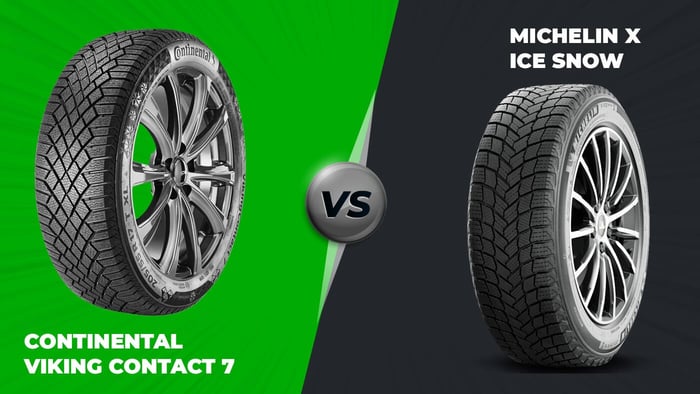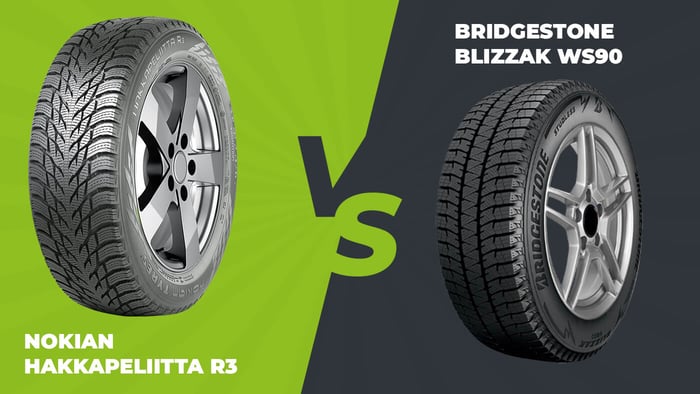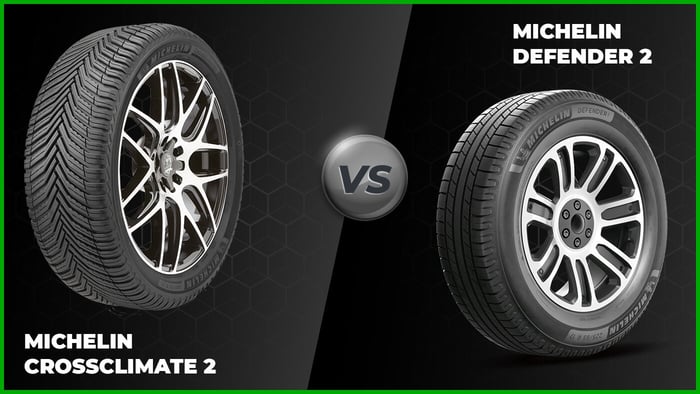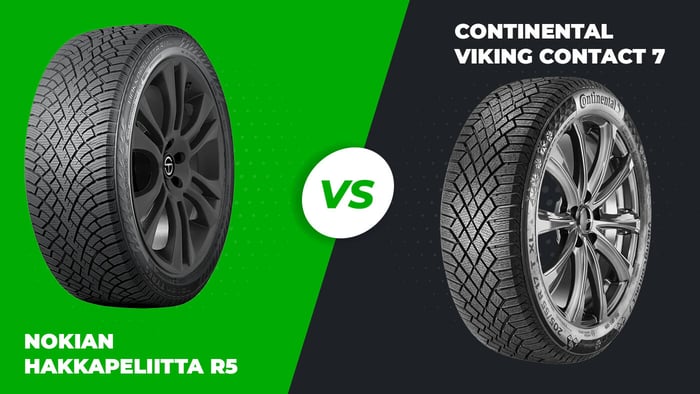div class="LS-post">
How do the Continental Viking Contact 7 vs Michelin X-Ice Snow compare?
Both tires are made by the greatest tire manufacturers; Continental and Michelin are two renowned European manufacturers that have years of experience. With multiple innovations under their belts, they have both designed studless winter tires that are among the best of their category.
On the one hand, you will find the Continental Viking Contact 7. This tire’s latest generation was revealed in 2018 and quickly made its way among the best. It was described by The Car Guide as “the best product the German manufacturer has ever offered” (2021).
First offered in dimensions ranging between 15- and 20- inches, the model later welcomed new dimensions ranging from 21- to 22- inches, to cater to the needs of even more drivers. The model is available in T and H speed ratings and is suited to a wide range of vehicles.
On the other hand, the Michelin X-Ice Snow was revealed a little more recently, in 2020. It came to replace two separate models, making it the ideal tire with perfectly balanced performance. It also became a ferocious rival to the Continental tire.
Also offered in 15- to 22- inches dimensions –for a total of 144-, it has improved the manufacturer’s selection since it arrived on the market. It is also offered in T and H speed ratings.
Something else both tires have in common: they are compatible with electric vehicles, offering the necessary levels of performance for these powerful –and often heavier- vehicles. Finally, they both rely on a directional tread without center ribbing and, in the last generation, have both added wider and better spaced grooves. These will provide you with solid resistance to aquaplaning and optimal evacuation of water and snow.
To better understand their respective design and differences, let’s take a closer look at their specs.
Continental Viking Contact 7: Specs
When the German manufacturer redesigned the Continental Viking Contact 7 tire, it became one of the most interesting winter tires on the market. To create a competitive tire, it relies on elements, like:
- A canola oil based compound
TheViking Contact’s silica compound contains canola oil, to ensure greater flexibility. This also allows the tire to maintain high grip levels in extreme temperatures, especially on snow and ice.
- Trapez 3D Sipes
The tire design contains Trapez 3D sipes, with different thicknesses. They create gripping edges that are especially efficient on snow, providing you with optimal traction and short braking distances on slippery road surfaces.
- A directional tread
The tire has a tread design that is specially made to evacuate water, snow and slush quickly, thanks to wider V-shaped grooves. These help ensure a safe driving experience without aquaplaning.
- Interlocked block bridges
Designed for a maximum of rigidity, the blocks will provide you with improved road handling. The tire’s interlocked design ensures a maneuverable and stable driving experience. By maximising the contact surface with the road, the model also prevents irregular wear, for optimized durability.
- RunFlat technology available
Some dimensions offer the reinforced sidewall technology, allowing you to drive for around 80 km after a flat, at a maximum speed of 80 km/hr. Peace of mind assured!
Michelin X-Ice Snow: Specs
The Michelin X-Ice Snow tire combines the qualities of its predecessors with notable improvements. These main features are:
- A Flex-Ice 2.0 tread compound
Just like the compound name indicates, flexibility on ice has been improved. The unique compound relies on a high silica concentration for a maximum of flexibility in extreme temperatures. The compound also improves the blocks’ rigidity for a maximum contact surface with the road.
- EverGrip Technology
With EverGrip, the tire relies on a few hundred sipes for added traction. They are revealed as the tire begins to wear, ensuring excellent traction throughout the tire’s lifespan, especially on snow.
- Two types of 3D sipes
For even more grip, the full-depth 3D sipes grip onto the road surface, even when covered in snow and ice. They create a claw effect that helps maximise traction and minimise the braking distances.
- An aggressive directional tread
The very first change brought to the newest generation of the tire, is the redesigned V-shaped tread. The grooves are also wider, helping evacuate water and snow more efficiently.
- The Piano Acoustic Tuning technology
The premium tire is also designed to provide you with an enjoyable driving experience, which is also comfortable and quiet. The polyurethane foam also helps reduce vibrations from forming within the tread, for a smoother and quieter ride.

Choosing between the Continental Viking Contact 7 and the Michelin X-Ice Snow
So, which is the best tire between the Continental Viking Contact 7 vs Michelin X-Ice Snow? Our answer, obviously, is that everything will depend on your needs, since both models are excellent tires. Each one does have its strengths, as the independent testing done by Tyre Reviews clearly demonstrates.
Firstly, given that we are dealing with a directional tread on both tires, the driving experience on wet roads is quite interesting; both tires also offer different strengths and qualities.
On the one hand, the Michelin tire offers the best resistance to aquaplaning in a straight line. On the other hand, the Continental tire offers shorter braking distances on wet roads, although the difference is not a significant one.
When it comes to braking distance on dry roads, the Continental tire also comes out on top, above the X-Ice Snow. It also offers excellent maneuverability on this type of surface. Maneuverability is one of its strength, but the same could be said of the Michelin tire, which also offers a balanced driving experience and precise steering response, especially on wet roads.
And what about driving on ice? The Continental tire stands out for speed and grip, while the Michelin tire offers a controlled drive while cornering. Although the Continental is a bit quicker, the Michelin’s braking distances are a bit shorter.
When it comes to driving on snow, it is the Michelin tire’s turn to be quicker and more maneuverable, also offering an enjoyable and easy driving experience. No matter what, both models offer very safe traction levels and braking distances, both on snow and ice.
Finally, a comfortable ride and a low rolling resistance are essential features when it comes to premium tires. Although both offer similar levels of comfort, the Viking Contact is the quieter of the two models.
On the other hand, the X-Ice Snow surpasses its rivals when it comes to rolling resistance: if you are looking to optimize your consumption, it could be the ideal choice!
Comparing warranties
Although both models are tested and true, the warranty could play a decisive role for some drivers. Firstly, you should know that both manufacturers offer a competitive 60- day satisfaction guarantee upon the purchase of your new set of tires!
To this, Michelin adds the standard limited warranty and a 60,000 km warranty on tread life.
As for the Continental tire, the limited warranty adds road side assistance for a period of 3- years, including a free tire change or towing for up to 250 kilometers, along with a protection from road hazards.
As you can see, they both offer an advantageous warranty. No matter if you are leaning towards a low rolling resistance like the one Michelin offers or the remarkably quiet driving experience offered by Continental, you will be taking advantage of tires that offer great performance in all winter conditions.
To purchase your next set, shop with blackcircles Canada, where you will find the best prices on the market.






